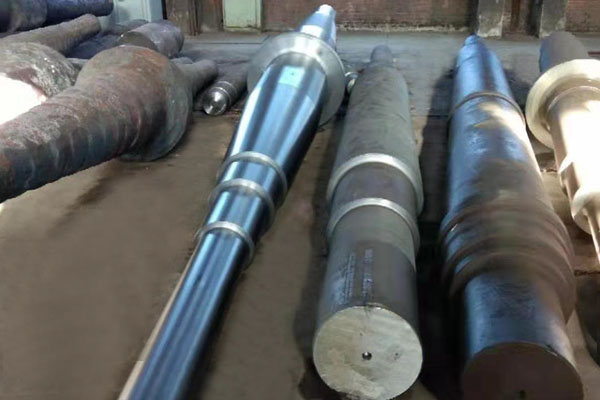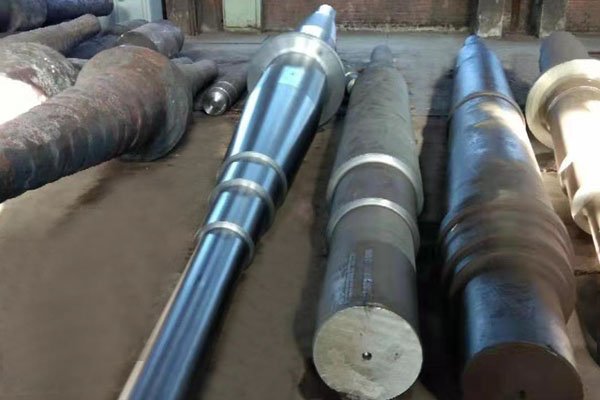

锻件厂家表面质量的检验普通来讲是属于非毁坏性的检验,平时用肉眼或低倍放大镜进行搜检,须要时也接纳无损探伤的技巧。而里面质量的检验,因为其搜检内容的要求,有些必需接纳毁坏性检验,也即是平时所讲的解剖实验,如低倍检验、断口检验、高倍构造检验、化学成分说明和力学性能测试等,有些则也能够接纳无损检验的技巧,而为了更精准地评估锻件质量,应将毁坏性实验技巧与无损检验技巧互相连结起来进行应用。而为了从深档次上说明锻件质量题目,进行机理性的研究事情还要籍助于透射型或扫描型的电子显微镜、电子探针等。
平时锻件里面质量的检验技巧可归结为:宏观构造检验法、微观构造检验法、力学性能检验、化学成分说明法及无损检验法。
宏观构造检验即是接纳目视或者低倍放大镜(普通倍数在30×以下)来调查说明锻的低倍构造特性的一种检验。对于锻件的宏观构造检验常用的技巧有低倍侵蚀法(包含热蚀法、冷蚀法及电解侵蚀法)、断口实验法和硫印法。
低倍侵蚀法用以搜检布局钢、不锈钢、高温合金、铝及铝合金、镁及镁合金、铜合金、钛合金等质料锻件的裂纹、折叠、缩孔、气孔偏析、白点、疏松、非金属同化、偏析会聚、流线的分布形式、晶粒大小及分布等。只但是对于差别的质料闪现低倍构造时接纳的浸蚀剂和浸蚀的规范差别。
断口实验法用以搜检布局钢、不锈钢(奥氏体型除外)的白点、层状、内裂等缺点、搜检弹簧钢锻件的石墨碳及上述各钢种的过热、过烧等,对于铝、镁、铜等合金用来搜检其晶粒是否细致匀称,是否有氧化膜、氧化物同化等缺点。
而硫印法主要运用于某些布局钢的大型锻件,用以搜检其硫的分布是否匀称及硫含量的几许。
除布局钢、不锈钢锻件用于低倍搜检的试片不进行最终热处分外,其余质料的锻件普通都经过最终热处分后才进行低倍检验。
断面试样普通都进行划定的热处分。
微观构造检验法则是行使光学显微镜来搜检种种质料商标锻件的显微构造。搜检的名目普通有素质晶粒度,或者是在划定温度下的晶粒度,即现实晶粒度,非金属同化物,显微构造如脱碳层、共晶碳化物不匀称度,过热、过烧构造及其它要求的显微构造等。
力学性能和工艺性能的检验则是对曾经过划定的最终热处分的锻件和试片加工成划定试样后行使拉力实验机、打击实验机、永远实验机、委靡实验机、硬度计等仪器来进行力学性能及工艺性能数值的测定。
化学成分的测试普通是接纳化学说明法或光谱说明法对锻件的成分进行说明测试,跟着科学技术的发展,无论是化学说明或是光谱说明其说明的手段都有了进步。对于光谱说明法而言,当今已不单纯接纳看谱法和摄谱法来进行成分说明,新出现的光电光谱仪不但说明速率快,并且精准性也大大地进步了,而等离子光电光谱仪的出现更大大地进步了说明精度,其说明精度可达10-6级,这对于说明高温合金锻件中的微量有害杂质如Pb、As、Sn、Sb、Bi等短长常卓有成效的技巧。
以上所说的技巧,无论是宏观构造检验法,或是微观构造检验法或性能及成分测定法,均属于毁坏性的实验技巧,对于某些紧张的、大型的锻件毁坏性的技巧已不行彻底适应质量检验的要求,这一方面是因为太不经济,另一方面主要是为了避免毁坏性搜检的片面性。无损检验技术的发展为锻件质量检验提供了更好更美满的手段。
对于锻件的质量检验所接纳的无损检验技巧普通有:磁粉检验法、渗透检验法、涡流检验法、超声波检验法等。
磁粉检验法宽泛地用于搜检铁磁性金属或合金锻件的表面或近表面的缺点,如裂纹、发纹、白点、非金属同化、分层、折叠、碳化物或铁素体带等。
该技巧仅适合于铁磁性质料锻件的检验,对于奥氏体钢制成的锻件不适于接纳该技巧。
渗透检验法除能搜检磁性质料锻件外,还能搜检非铁磁性质料锻件的表面缺点,如裂纹、疏松、折叠等,普通只用于搜检非铁磁性质料锻件的表面缺点,不行发现隐在表面以下的缺点。
涡流检验法用以搜检导电质料的表面或近表面的缺点。
The inspection of the surface quality of forgings is generally a non-destructive inspection. It is usually inspected with the naked eye or a low magnification magnifying glass, and the technique of nondestructive testing is also accepted when necessary. In the quality inspection, because of the requirements of the inspection content, some must accept the destructive test, that is, the anatomical experiments usually mentioned, such as low-power test, fracture test, high-structural test, chemical composition description and mechanical property test. Etc. Some can also accept non-destructive testing techniques, and in order to more accurately assess the quality of forgings, destructive experimental techniques and non-destructive testing techniques should be linked together for application. In order to explain the quality problems of forgings from the deep grades, the mechanism research is to be assisted by transmission or scanning electron microscopes, electron probes, and the like.
The quality inspection techniques in forgings can be summarized as follows: macroscopic structural test method, microstructural test method, mechanical property test, chemical composition description method and nondestructive test method.
The macroscopic structural test is a test that accepts a visual or low magnification magnifying glass (normal multiples below 30×) to investigate the low-fold structural characteristics of the forging. Common techniques for the macroscopic structural inspection of forgings are low-penetration methods (including thermal erosion, cold erosion and electrolytic erosion), fracture experiments and sulfur printing.
The low-frequency erosion method is used to search for cracks, folds, shrinkage holes, pore segregation, white spots, looseness, and forgings of materials such as steel, stainless steel, high-temperature alloy, aluminum and aluminum alloy, magnesium and magnesium alloy, copper alloy, and titanium alloy. Non-metal assimilation, segregation and convergence, distribution patterns of streamlines, grain size and distribution, etc. Only for differential materials, the difference in specifications of the etchant and etch received during the low-fold construction is shown.
The fracture test method is used to check the defects such as white spots, layered and internal cracks of the layout steel and stainless steel (excluding the austenitic type), the graphite carbon of the spring steel forgings, and the overheating and overheating of the above steel grades. For aluminum, magnesium, copper and other alloys used to check whether the crystal grains are finely symmetrical, whether there are defects such as oxide film and oxide assimilation.
The sulphur printing method is mainly used for large forgings of some layout steels, to check whether the distribution of sulfur is symmetrical and the sulfur content is a few.
Except for layout steel and stainless steel forgings, the test pieces for low-level inspection are not subjected to the final heat treatment, and the forgings of the other materials are generally subjected to the final heat treatment before the low-power test.
The section specimens are generally subjected to delineated heat treatment.
The microstructural test rule is to use an optical microscope to search the microstructure of various trademark forgings. The name of the inspection is generally of a quality grain size, or the grain size at the delineated temperature, that is, the actual grain size, the non-metal assimilates, the microstructure such as the decarburization layer, the eutectic carbide unevenness, Overheated, overfired structures and other required microstructures.
The test of mechanical properties and process performance is to apply the tensile test machine, the impact test machine, the forever test machine, the euphemism test machine, the hardness tester, etc. to the forged piece and the test piece which have been demarcated for the final heat treatment. The instrument is used to determine the mechanical properties and process performance values.
The chemical composition test is generally to accept the chemical description method or the spectral description method to explain and test the composition of the forging part. With the development of science and technology, both the chemical explanation and the spectrogram indicate the means of explanation. For the spectroscopic method, the spectroscopic and spectroscopic methods are not simply accepted for composition description. The emerging optoelectronic spectrometer not only shows that the rate is fast, but also the accuracy is greatly improved, and the appearance of the plasma photoelectric spectrometer is more The accuracy of the description has been greatly improved, and the accuracy of the description is up to 10-6. This is an effective technique for explaining the short and long-term harmful impurities such as Pb, As, Sn, Sb, Bi, etc. in the high-temperature alloy forgings.
The techniques mentioned above, whether it is macroscopic structural test, or microstructural test or performance and composition determination, are destructive experimental techniques. For some nervous, large forgings, the destructive skills are not complete. Adapting to the requirements of quality inspection, this aspect is because it is too uneconomical, and on the other hand, it is mainly to avoid the one-sidedness of destructive inspection. The development of non-destructive testing technology provides a better and more satisfactory means for forging quality inspection.
The non-destructive testing techniques accepted for the quality inspection of forgings are: magnetic particle test, penetration test, eddy current test, ultrasonic test, etc.
Magnetic particle inspection is widely used to detect defects on the surface or near surface of ferromagnetic metal or alloy forgings, such as cracks, hair lines, white spots, non-metal assimilation, delamination, folding, carbide or ferrite bands.
This technique is only suitable for the inspection of ferromagnetic material forgings, and forgings made of austenitic steel are not suitable for this technique.
In addition to the inspection of magnetic material forgings, the penetrant inspection method can also detect the surface defects of non-ferromagnetic material forgings, such as cracks, looseness, folding, etc., which are generally only used to check the surface defects of non-ferromagnetic forgings. The disadvantages hidden below the surface.
Eddy current testing is used to check for defects in the surface or near surface of conductive materials.
